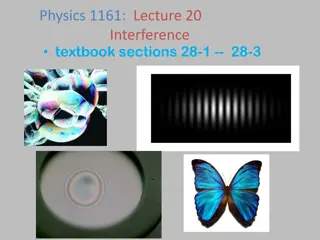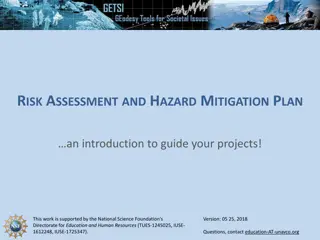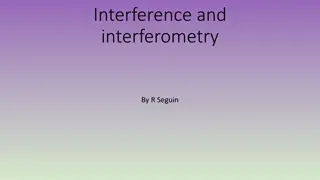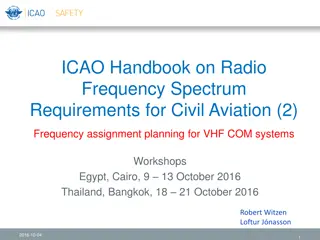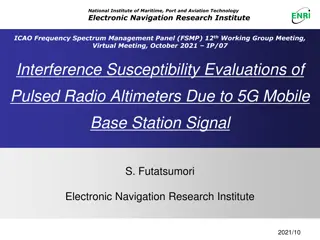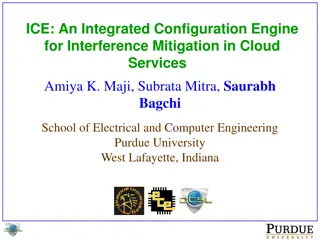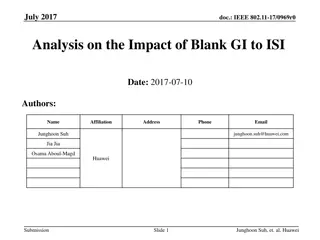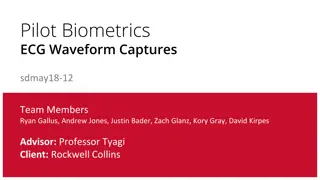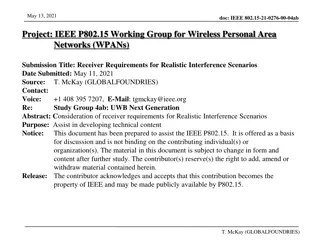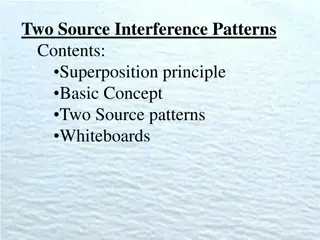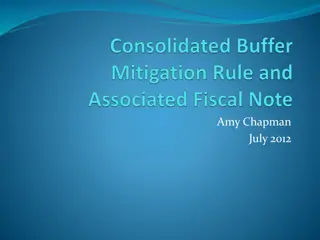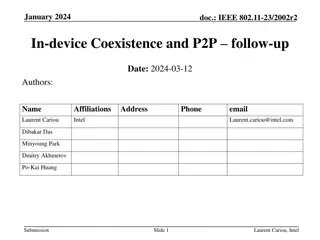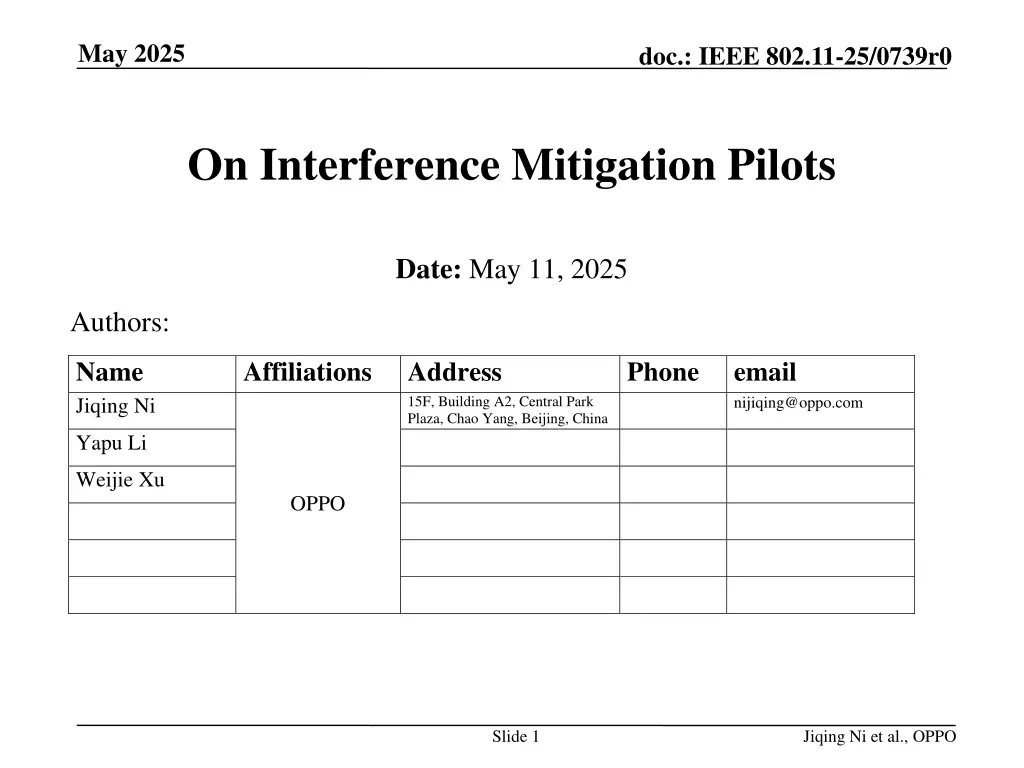
Understanding Interference Mitigation in Wireless Communication
Explore the various sources of interference in wireless communication systems, such as Bluetooth, UWB, radar, WLAN, and more. Discover potential scenarios for interference mitigation pilots to improve data transmission performance and handle different types of interference efficiently.
Download Presentation

Please find below an Image/Link to download the presentation.
The content on the website is provided AS IS for your information and personal use only. It may not be sold, licensed, or shared on other websites without obtaining consent from the author. If you encounter any issues during the download, it is possible that the publisher has removed the file from their server.
You are allowed to download the files provided on this website for personal or commercial use, subject to the condition that they are used lawfully. All files are the property of their respective owners.
The content on the website is provided AS IS for your information and personal use only. It may not be sold, licensed, or shared on other websites without obtaining consent from the author.
E N D
Presentation Transcript
May 2025 doc.: IEEE 802.11-25/0739r0 On Interference Mitigation Pilots Date: May 11, 2025 Authors: Name Jiqing Ni Affiliations Address 15F, Building A2, Central Park Plaza, Chao Yang, Beijing, China Phone email nijiqing@oppo.com Yapu Li Weijie Xu OPPO Slide 1 Jiqing Ni et al., OPPO
May 2025 doc.: IEEE 802.11-25/0739r0 Interference Sources To understand the interference Sources [1]: Bluetooth [2.4GHz, 1/2 MHz, low power, 1600/ x0-x00hop/s, 600us/x-x0ms per hop] UWB [3-10GHz, wideband, very low power, >500MHz] Radar [ 2-4GHz(S band) and other bands, wideband] WLAN Sig (11b/11a/ , OBSS, fully or partially overlapped) Spur (from RF or other sources, like USB) Dc leakage [supported from the beginning with null subcarriers around indices as 0 ] Other signals (NRU, LTEU, or other signals) Interference type at frequency domain Partial band/wideband Narrow band with hopping or not Spur like Inband, ACI or AACI Interference type at Time domain It happens within STF (AGC), or any data Part (Detect) Slide 2 Jiqing Ni et al., OPPO
May 2025 doc.: IEEE 802.11-25/0739r0 Potential Scenarios for IM Pilots (1) ACI spur Narrow Band UHR Preamble UHRSTF /UHRLTF Transmission Data LSIG&RLSIG LSTF/LLTF Partially overlapped Band Benefits may be achieved with following methods: For interference with small power, IM pilots would be utilized within equalizer with interference reduction & whiten. For narrow band or spur with large power, the soft LLR of the symbols around the interference would be set as 0 or updated directly. For too large interference , the receiver may drop the rxProcess for power saving. It would provide better noise estimation performance for bands without interference. The interference info could be reported to aid the data transmission or retransmission. Slide 3 Jiqing Ni et al., OPPO
May 2025 doc.: IEEE 802.11-25/0739r0 Potential Scenarios for IM Pilots (2) Co-SR SR Data Transmission OBSS interference For Spatial Reuse, The intended data transmission would overlap the OBSS interference. The transmitter that knows the interference info could utilize the IM pilots to improve detect performance; The OBSS interference may be partially or fully band-overlapped. For Co-SR, A sharing AP shall transmit a Trigger frame to initiate concurrent Co-SR transmissions with one other AP within its obtained TXOP BW. IM pilots could be configured to improve the link perf if necessary. Slide 4 Jiqing Ni et al., OPPO
May 2025 doc.: IEEE 802.11-25/0739r0 Observations Equally distributed IM Pilots would provide better performance due to the randomness of interference. To handle Bluetooth-like narrowband interference, the density of IM Pilots had better be around 1-2 MHz. It seems there is no restriction for IM pilots utilized with OFDMA system. As the interference could be overlapped with partial or full band, perSTA IM pilots configuration seems more flexible. It would be much helpful for IM configuration if the transmitter knows the interference information, link SR/Co-SR scenarios. Slide 5 Jiqing Ni et al., OPPO
May 2025 doc.: IEEE 802.11-25/0739r0 IM Pilots normal Pilots zero-energy Pilots chanEst/PT impacts Depends on chanEst perf Not depends on chanEst perf Interference power impacts Not depends on interference power Worse perf for low power Noise Est perf No gain for noiseEst. NoiseEst gain Seq design Need Not need From our perspective, zero-energy (null-subcarrier) pilots would be preferred, as it would provide better interference estimation performance, and there is less standardization work for sequence design. Slide 6 Laurent Cariou, Intel
May 2025 doc.: IEEE 802.11-25/0739r0 An Example on IM pilots (20MHz) -29 -55 55 83 109 29 -83 -109 20MHz -36 -22 -10 -62 -48 36 62 90 116 10 22 48 76 102 -102 -90 -76 -116 0 -95 : -70 -69 -68 : -43 -42 : -17 -122 -121 : -96 4 : 16 -16 : -4 17 : 42 69 70 : 95 96 : 121 122 43 : 68 127 RU-26 -128 0 -69 -68 : -17 -121 : -70 1 : 16 -122 -16 : -1 69 70 : 121 122 17 : 68 127 RU-52 -128 0 17 : 122 -122 : -17 1 : 16 -123 -16 : -1 123 127 RU-106 -128 0 2 : 122 -123 123 1 -1 -122 : -2 127 RU-242 -128 Slide 7 Jiqing Ni et al., OPPO
May 2025 doc.: IEEE 802.11-25/0739r0 An Example on IM pilots (40MHz) -123 -177 -205 -231 -97 -151 -71 -43 -17 -158 -184 -144 -212 -198 -130 -90 -238 -224 -170 -116 -104 -64 -36 -10 -78 -50 -24 0 -163 : -138 -109 : -84 -83 : -58 -55 : -30 -217 : -192 -189 : -164 -29 : -4 -256:-244 -136 : -111 -243 : -218 RU-26 0 -256:-244 -243 : -192 -189 : -138 -109 : -58 -55 : -4 -137 : -110 RU-52 0 -256:-244 -243 : -138 -109 : -4 -137 : -110 RU-106 0 -256:-245 -243 : -3 RU-242 0 -256:-245 -243 : -3 RU-484 Slide 8 Jiqing Ni et al., OPPO
May 2025 doc.: IEEE 802.11-25/0739r0 An Example on IM pilots (80MHz) -25 -51 -79 -105 -159 -185 -133 -213 -273 -239 -433 -327 -353 -299 -407 -461 -487 -379 -32 -18 -58 -44 -72 -86 -112 -98 -292 -280 -266 -306 -192 -178 -334 -320 -140 -126 -360 -346 -220 -206 -246 -232 0 -152 -166 -386 -372 -414 -400 -440 -426 -468 -454 -494 -480 -118 : -93 -172 : -147 -92 : -67 -64 : -39 -419 : -394 -365 : -340 -339 : -314 -145 : -120 -38 : -13 -445 : -420 -311 : -286 -285 : -260 -226 : -201 -198 : -173 -392 : -367 -252 : -227 -12 : -4 -473 : -448 -512:-500 -499 : -474 RU-26 0 -118 : -67 -64 : -13 -365 : -314 -145 : -120 -445 : -394 -311 : -260 -198 : -147 -392 : -367 -252 : -201 -12 : -4 -512:-500 -499 : -448 RU-52 0 -118 : -13 -365 : -260 -145 : -120 -392 : -367 -252 : -147 -12 : -4 -512:-500 -499 : -394 RU-106 0 -500 : -259 -253 : -12 -11 : -4 -512:-501 RU-242 0 -500 : -259 -253 : -12 -11 : -4 -512:-501 RU-484 0 -500 : -259 -500 : -3 -512:-501 RU-996 12 Slide 9 Jiqing Ni et al., OPPO
May 2025 doc.: IEEE 802.11-25/0739r0 Proposal 1. Almost equally distributed IM Pilots pattern with around 1-2 MHz density, is preferred no matter what the BW is. 2. zero-energy pilot (null pilot) is supported. 3. IM pilots could be configured perSTA within OFDMA system. Slide 10 Jiqing Ni et al., OPPO
May 2025 doc.: IEEE 802.11-25/0739r0 References [1] 11-24-1264r0: Supporting Rx Interference Mitigation in TGbn (Shimi Shilo et al) Slide 11 Jiqing Ni et al., OPPO




